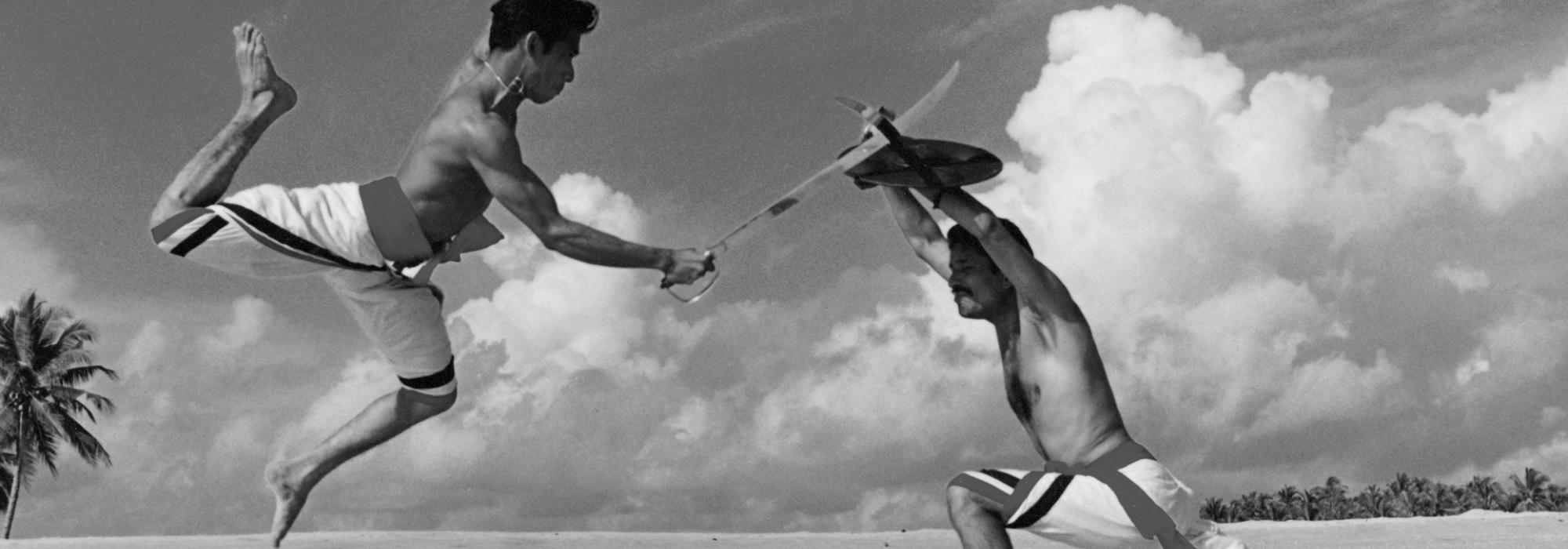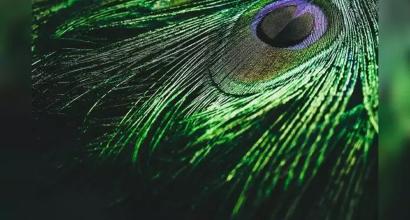(.. continued)
Battle-field has not only inspired dance, but also music and literature in India. The gamakas (embellishments in music), rhythmic patterns, the name of the taalas (rhythmic cycles), musical instruments and their playing style have all been influenced by battle techniques. However, unlike in nrtya, movements cannot be depicted in music or literature. Only the intensity, energy and fervor that can be seen in a battle can be felt through these rhythmic patterns and meters. It is all the more evident in the category of poetry connected with linguistic acrobatics (chitra kavita). It uses several patterns such as ‘gaja-pada’ (elephant-gait), ‘ratha-pada’ (chariot movement), 'ashva-pada'(horse-gait), ‘ardha-bhramaka’ (partial-spinning) and schemes such as ‘khadga’ (sword), ‘shoola’ (spear), ‘kheta’ (shield), ‘kunta’ (lance), ‘musala’ (club), ‘shara’ (arrow), ‘dhanu’ (bow), ‘chakra’ (disc), ‘parashu’ (axe). These stand as examples to prove the close relationship between battle and the art of prosody.
[contextly_sidebar id="P2zg0SkKr3B6lxwrGSUdMs4nGez1VBtK"]
Several deshi (regional) dance styles like ‘gaundali’, ‘prerani’, ‘mailara’, ‘kamsaale’, ‘veeragaase’ and ‘raasaka’ have war-like movements and have derived inspiration from battles. Instruments such as panava, anaka, gomukha, dundubhi, turya, shanka (conch) and jaya-ghantaa were all originally used in battles, before they were employed in dance. In a work called ‘Nryta-sarvasa’, there is a description of a certain dance-form, in which dancers hold a sharp sword in their hands. Many of the sculptures belonging to the times of Kalyana-chalukyas and Chandela-pratihaaras, have dancing couples, who hold sword and shield in their hands. ‘Veeragaase’ of Karnataka (the dance of veera-bhadra of Andhra Pradesh) is a nice example of how the tradition has remained intact even to this day. ‘Kanduka-nrtta’ (dance with ball) has many formations that give us a feel of battle. These kinds of dances are described in ‘Nrtta-ratnaavali’ of Jayapasenani and ‘Manasollasa’ of Someshwara. Pandarikavittala, a dance and music scholar from Karnataka who resided in Akbar’s court, describes several ‘bandha-nrtyas’ (dance formations) in his work ‘Nartana-nirnaya’. Those deshi dance forms too are full of movements similar to those on the battle-field.
‘Dombaraata’, which is popular in Karnataka and is seen all over India in different forms, has its origin in battle and hunting. It is evident that sports too derive their inspiration from battle and hunting. Fencing, wrestling, boxing, horse riding, horse race, polo (on horse and elephant back – known as ‘gendika’ or ‘geddika’ in ancient India), discus throw, javelin throw and other athletic sports have employed elements from the battle field for entertainment and as a display of caliber. In ancient Greece too, whenever a hero or a king died, a few days of sport and contests were held in the person’s honour. This is evident in the epic poems of Greece and Rome, such as Iliad and Odyssey of Homer and Aeneid of Virgil. Moreover, sports like cricket, football, basket-ball, baseball and rugby, where two teams compete for victory, have a kind of warring spirit and are filled with agility. Chess, which is said to have originated in India, is afterall a complete translation of battle into sport. The movements of the bishop, rook, knight and infantry in chess are just like planned movements on a battle-field. Several times, these sports have even resulted in fierce competition leading to combats. Whereas the competitive spirit in sports can get aggravated to the level of a battle, and it does not go to that extreme in arts, we have seen jugalbandhis (two artists performing together), where a heated competition between the two can lead to a subtle fight to establish superiority.
Buddhist monks who migrated from India to countries like China, Japan and Korea, took martial arts such as karate, judo, kung-fu, etc. along with them. It is also interesting to note that the ‘samurai’ war technique, which evolved in Japan during the 16th century, is employed in the field of management even today! Moreover, the Buddhist monks who took these martial arts to the far eastern countries, even evolved meditation techniques such as Zen that helped them in their spiritual progress. Thus, we can say that the battle-field is not just resulted in the eight rasas of art, but also in the sublime rasa of ‘shaanta’ (peace). Peace is the culmination of all the endeavors of our body and mind.
Having seen examples so far, let us try to examine the philosophical background of battle-field resulting in theater. Anthropologists and sociologists say that early man metamorphosed his real life experiences of hunting and fighting as means of entertainment, by giving them the shape of rituals and arts. Even if we accept their argument, it still does not explain why man adapted these very same activities for his entertainment. It is probably because anthropologists and sociologists think only at the level of the physical and emotional. However, one must view this from the perspective of philosophy to gain a better insight. (Looking through the eyes of philosophy does not mean that we discard scientific outlook and take to superstition. We consider our very being as the aatman and a well reasoned approach to contemplate on our being is adhyaatma, i.e., philosophy). Thus, only when we go into the philosophy of arts can we find a convincing answer.
A battle field is a playground of profit and loss, victory and defeat. It is the same with regard to hunting too. What drives both is fury and hatred. Both hunting and war are essential for one’s survival. Moreover, in a battle for love too, fulfillment of lust leads to momentary peace, if not, that too would lead to hatred. ‘Kaama’ or desire is fundamental to battle, hunting and lust. An unfulfilled desire leads to fury. A weak person’s fury turns into jealousy. A temporarily fulfilled desire progressively leads to possession, passion and pride (lobha-moha-mada). When such realistic aspects are sublimated to ideality, a battle-field gets transformed into a theater. One transcends the duality of profit-loss, victory-defeat and experiences aesthetic bliss, which is rasa. Thus, the rana-ranga (battle-filed) is metamorphosed to rasa-ranga (Rasa-field). Rana-ranga is a fact and rasa-ranga is a value. M. Hiriyanna says ‘that which does not end in itself is not a value’ and it is in this background that Sri Krishna told Arjuna to consider the rana-ranga as rasa-ranga and fight. This is in fact activity without attachment – karma-yoga. It is not ego that is present in rasa, but sublime Bliss.
Adapted from Kannada by Arjun Bharadwaj
(The original article is from the anthology Kalaakautuka)











































